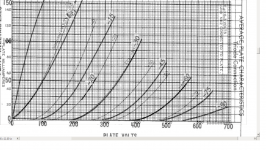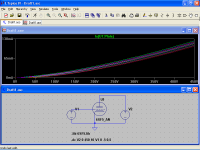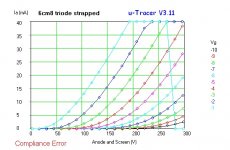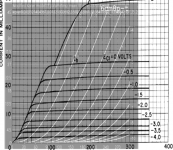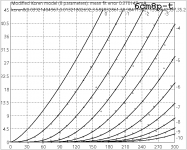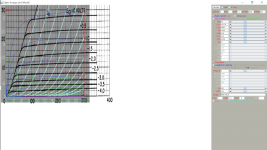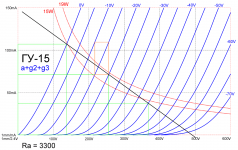No, it’s not. I made that one.
Ah, the copyright applies to the process or the general form of the model then. Thanks for the effort!
I had stumbled on the GE compactron lists too but there were no models for the tubes I was interested in even when I knew what other devices they were similar too. Unless I missed them somehow.... They are not terribly useful for building traditional amplifiers with modest to high outputs but they are useful for oddball projects and NOS stock is still often quite cheap so they are tempting.
Hi jazbo et al.
I haven't been here for a while..but been busy working on modeling/simulating stuff all the same. I'm collecting a number of popular guitar amp output tube models, and have recently converted Ayumi's models to pspice format. However, one that I have not yet come across is the 5881. I know this is supposed to be equivalent to the 6L6GB, but that is a version with lower power and max plate voltage. I've read that the 5881 does sound different than a 6L6GC, therefore it would be nice to have a spice model for the 5881.
Please set me straight if there is no benefit to a separate 5881 model, apart from the 6L6GC one, and let me know if I can help with the modeling.
Thanks!
A model for the 6973 would be nice to have as well.
Thanks!
Data sheets soon...
Here is the triode-connected curve sheet for the 5881. Unfortunately, no such curves seem available for either the 6973, nor its supposed equivalent the 6CZ5.
I haven't been here for a while..but been busy working on modeling/simulating stuff all the same. I'm collecting a number of popular guitar amp output tube models, and have recently converted Ayumi's models to pspice format. However, one that I have not yet come across is the 5881. I know this is supposed to be equivalent to the 6L6GB, but that is a version with lower power and max plate voltage. I've read that the 5881 does sound different than a 6L6GC, therefore it would be nice to have a spice model for the 5881.
Please set me straight if there is no benefit to a separate 5881 model, apart from the 6L6GC one, and let me know if I can help with the modeling.
Thanks!
A model for the 6973 would be nice to have as well.
Thanks!
Data sheets soon...
Here is the triode-connected curve sheet for the 5881. Unfortunately, no such curves seem available for either the 6973, nor its supposed equivalent the 6CZ5.
Attachments
If you want to make your own triode models, I wrote a program to for this. It is an interactive solution that allows you to change parameters until you get a good fit for a particular triode.
The parameters follow the improved formulas outlined on the Norman Koren audio page. There are a few examples in the download. I think you can figure it out from those.
Download:
K4BPM PSPICE Home Page
Jim
The parameters follow the improved formulas outlined on the Norman Koren audio page. There are a few examples in the download. I think you can figure it out from those.
Download:
K4BPM PSPICE Home Page
Jim
A bit of graphics work seems to have revealed that the 5881 and 6L6GC triode-connected curves may be close enough that a 5881 model is unnecessary.
The -30V and -60V grid lines match almost perfectly, while the 0V curve is probably close enough. Only these 3 values are comparable between the two due to different grid sweeps used.
The -30V and -60V grid lines match almost perfectly, while the 0V curve is probably close enough. Only these 3 values are comparable between the two due to different grid sweeps used.
Attachments
Code:* * Generic triode model: 6SF5_AN * Copyright 2003--2008 by Ayumi Nakabayashi, All rights reserved. * Version 3.10, Generated on Sat Dec 13 18:55:08 2014 * Plate * | Grid * | | Cathode * | | | .SUBCKT 6SF5_AN A G K BGG GG 0 V=V(G,K)+0.99999997 BM1 M1 0 V=(0.031634481*(URAMP(V(A,K))+1e-10))**-0.46975888 BM2 M2 0 V=(0.76151452*(URAMP(V(GG)+URAMP(V(A,K))/7.5387827)+1e-10))**1.9697589 BP P 0 V=0.00039029593*(URAMP(V(GG)+URAMP(V(A,K))/9.8997228)+1e-10)**1.5 BIK IK 0 V=U(V(GG))*V(P)+(1-U(V(GG)))*0.00022622154*V(M1)*V(M2) BIG IG 0 V=0.00019514796*URAMP(V(G,K))**1.5*(URAMP(V(G,K))/(URAMP(V(A,K))+URAMP(V(G,K)))*1.2+0.4) BIAK A K I=URAMP(V(IK,IG)-URAMP(V(IK,IG)-(0.00025575454*URAMP(V(A,K))**1.5)))+1e-10*V(A,K) BIGK G K I=V(IG) * CAPS CGA G A 2.4p CGK G K 4p CAK A K 3.6p .ENDS
DO NOT USE this model, it is highly inaccurate, plate current is about two orders of magnitude higher.
See for yourself
https://frank.pocnet.net/sheets/049/6/6SF5.pdf
Attachments
Try this. I just made this quickly but it seems like a good fit.
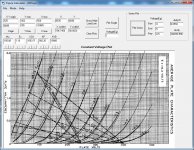
so:

so:
Code:
.SUBCKT 6SF5 1 2 3 ; P G C;
+ PARAMS: MU=105.88 EX=1.16 KG1=1093.71 KP=992.2 KVB=10000 RGI=2000
+ CCG=4.0P CGP=2.4P CCP=3.6P ; ADD .7PF TO ADJACENT PINS; .5 TO OTHERS.
e1 7 0 value=
+{v(1,3)/kp*log(1+exp(kp*(1/mu+v(2,3)/sqrt(kvb+v(1,3)*v(1,3)))))}
re1 7 0 1g
g1 1 3 value= {(pwr(v(7),ex)+pwrs(v(7),ex))/kg1}
rcp 1 3 1g
c1 2 3 {ccg}
c2 1 2 {cgp}
c3 1 3 {ccp}
r1 2 5 {rgi}
d3 5 3 dx
.model dx d(is=1n rs=1 cjo=10pf tt=1n)
.ends6cm8
here the triode strapped 6cm8 pentode, can you calculate the spice model?
No, I need the triode-connected curve for the pentode to make the model.
here the triode strapped 6cm8 pentode, can you calculate the spice model?
Attachments
Good catch, I must have copied the wrong file, the correct SPICE model is as follow:DO NOT USE this model, it is highly inaccurate, plate current is about two orders of magnitude higher.
Code:
*
* Generic triode model: 6SF5_AN
* Copyright 2003--2008 by Ayumi Nakabayashi, All rights reserved.
* Version 3.10, Generated on Sat Dec 13 18:55:08 2014
* Plate
* | Grid
* | | Cathode
* | | |
.SUBCKT 6SF5_AN A G K
BGG GG 0 V=V(G,K)+0.4894906
BM1 M1 0 V=(0.0018194781*(URAMP(V(A,K))+1e-10))**-0.29474303
BM2 M2 0 V=(0.83577425*(URAMP(V(GG)+URAMP(V(A,K))/90.259814)+1e-10))**1.794743
BP P 0 V=0.00099890055*(URAMP(V(GG)+URAMP(V(A,K))/107.99545)+1e-10)**1.5
BIK IK 0 V=U(V(GG))*V(P)+(1-U(V(GG)))*0.00061836196*V(M1)*V(M2)
BIG IG 0 V=0.00049945028*URAMP(V(G,K))**1.5*(URAMP(V(G,K))/(URAMP(V(A,K))+URAMP(V(G,K)))*1.2+0.4)
BIAK A K I=URAMP(V(IK,IG)-URAMP(V(IK,IG)-(0.00051335655*URAMP(V(A,K))**1.5)))+1e-10*V(A,K)
BIGK G K I=V(IG)
* CAPS
CGA G A 2.4p
CGK G K 4p
CAK A K 3.6p
.ENDSGood catch, I must have copied the wrong file, the correct SPICE model is as follow:
Thank you very much!
here the triode strapped 6cm8 pentode, can you calculate the spice model?
Apart from error from computation in your curve tracer there are useful plot points which will allow forward correction in Curve Capator. In addition, the original screen data is also used as a reference. So altogether this produce the pentode curve, see any good.
Code:
**** 6CM8P ******************************************
* Created on 05/08/2018 18:35 using paint_kip.jar
* [url=http://www.dmitrynizh.com/tubeparams_image.htm]Model Paint Tools: Trace Tube Parameters over Plate Curves, Interactively[/url]
* Plate Curves image file: 6cm8p1.png
* Data source link: <plate curves URL>
*----------------------------------------------------------------------------------
.SUBCKT 6CM8P 1 2 3 4 ; P G K G2
+ PARAMS: CCG=6P CGP=0.02P CCP=2.6P RGI=2000
+ MU=36 KG1=1289.7 KP=141.1 KVB=19.6 KVC=1.8 VCT=0.76 EX=1.65 KG2=1877
* Vp_MAX=300 Ip_MAX=30 Vg_step=1 Vg_start=0 Vg_count=11
* Rp=1600 Vg_ac=23.5 P_max=2 Vg_qui=-23.4 Vp_qui=240 UL=0.43 EG2=150
* X_MIN=42 Y_MIN=36 X_SIZE=564 Y_SIZE=623 FSZ_X=1942 FSZ_Y=1102 XYGrid=false
* showLoadLine=n showIp=y isDHP=n isPP=n isAsymPP=n isUL=n showDissipLimit=y
* showIg1=n gridLevel2=n isInputSnapped=n
* XYProjections=n harmonicPlot=y harmonics=y
*----------------------------------------------------------------------------------
RE1 7 0 1G ; DUMMY SO NODE 7 HAS 2 CONNECTIONS
E1 7 0 VALUE= ; E1 BREAKS UP LONG EQUATION FOR G1.
+{V(4,3)/KP*LOG(1+EXP((1/MU+(VCT+V(2,3))/V(4,3))*KP))}
G1 1 3 VALUE={(PWR(V(7),EX)+PWRS(V(7),EX))/KG1*ATAN(V(1,3)/KVB)}
* Alexander Gurskii screen current, see audioXpress 2/2011
RE2 8 3 1G ; Dummy
G2 8 3 VALUE={(PWR(V(7),EX)+PWRS(V(7),EX))/KG2*(KVC-ATAN(V(1,3)/KVB))}
E2 8 4 VALUE={0} ; Dummy
RCP 1 3 1G ; FOR CONVERGENCE
C1 2 3 {CCG} ; CATHODE-GRID 1
C2 1 2 {CGP} ; GRID 1-PLATE
C3 1 3 {CCP} ; CATHODE-PLATE
R1 2 5 {RGI} ; FOR GRID CURRENT
D3 5 3 DX ; FOR GRID CURRENT
.MODEL DX D(IS=1N RS=1 CJO=10PF TT=1N)
.ENDS
*$
Code:
* 6cm8p-t LTSpice model
.subckt 6cm8p-t P G K
Bp P K I=(0.03921404967m)*uramp(V(P,K)*ln(1.0+(0.01321802692)+exp((3.583832861)+(3.583832861)*((38.98411962)+(-139.8642937m)*V(G,K))*V(G,K)/sqrt((35.2957383)**2+(V(P,K)-(1.495413314))**2)))/(3.583832861))**(1.371612463)
.ends 6cm8p-tAttachments
Last edited:
A slight adjustment in plate current of previous post:
Code:
**** 6CM8P******************************************
* Created on 05/08/2018 19:27 using paint_kip.jar
* [url=http://www.dmitrynizh.com/tubeparams_image.htm]Model Paint Tools: Trace Tube Parameters over Plate Curves, Interactively[/url]
* Plate Curves image file: 6cm8p1.png
* Data source link: <plate curves URL>
*----------------------------------------------------------------------------------
.SUBCKT 6CM8P 1 2 3 4 ; P G K G2
+ PARAMS: CCG=6P CGP=0.02P CCP=2.6P RGI=2000
+ MU=35 KG1=1637.9 KP=148.2 KVB=18.6 KVC=2.25 VCT=0.806 EX=1.7 KG2=3998
* Vp_MAX=300 Ip_MAX=30 Vg_step=1 Vg_start=0 Vg_count=11
* Rp=1600 Vg_ac=23.5 P_max=2 Vg_qui=-23.4 Vp_qui=240 UL=0.43 EG2=150
* X_MIN=42 Y_MIN=36 X_SIZE=564 Y_SIZE=623 FSZ_X=1942 FSZ_Y=1102 XYGrid=false
* showLoadLine=n showIp=y isDHP=n isPP=n isAsymPP=n isUL=n showDissipLimit=y
* showIg1=n gridLevel2=n isInputSnapped=n
* XYProjections=n harmonicPlot=y harmonics=y
*----------------------------------------------------------------------------------
RE1 7 0 1G ; DUMMY SO NODE 7 HAS 2 CONNECTIONS
E1 7 0 VALUE= ; E1 BREAKS UP LONG EQUATION FOR G1.
+{V(4,3)/KP*LOG(1+EXP((1/MU+(VCT+V(2,3))/V(4,3))*KP))}
G1 1 3 VALUE={(PWR(V(7),EX)+PWRS(V(7),EX))/KG1*ATAN(V(1,3)/KVB)}
* Alexander Gurskii screen current, see audioXpress 2/2011
RE2 8 3 1G ; Dummy
G2 8 3 VALUE={(PWR(V(7),EX)+PWRS(V(7),EX))/KG2*(KVC-ATAN(V(1,3)/KVB))}
E2 8 4 VALUE={0} ; Dummy
RCP 1 3 1G ; FOR CONVERGENCE
C1 2 3 {CCG} ; CATHODE-GRID 1
C2 1 2 {CGP} ; GRID 1-PLATE
C3 1 3 {CCP} ; CATHODE-PLATE
R1 2 5 {RGI} ; FOR GRID CURRENT
D3 5 3 DX ; FOR GRID CURRENT
.MODEL DX D(IS=1N RS=1 CJO=10PF TT=1N)
.ENDS
*$Attachments
Can I make a request? Russian GU15 - Triode model desired
I searched high and low for a model, found this on diyAudio, Posted By matejsirk:
I haven't tried it yet.
I did find triode plate curves; hopefully they'll be useful (attached).
Incomplete data sheet
I can't seem to find inter-electrode capacitances in any data sheets, but matejsirk used CCG=3P CGP=1.4P CCP=1.9P.
I hope that's enough info for a good model. Or perhaps the model above is all that is needed; in which case, add it to the collection!
--
I searched high and low for a model, found this on diyAudio, Posted By matejsirk:
Code:
**** GU15TRIODE ******************************************
* Created on 07/30/2014 10:24 using paint_kit.jar
* Model Paint Tools: Trace Tube Parameters over Plate Curves, Interactively
* Curves image file: gu15triode.gif
* Data source link:
*----------------------------------------------------------------------------------
.SUBCKT GU15T 1 2 3 ; Plate Grid Cathode
+ PARAMS: CCG=3P CGP=1.4P CCP=1.9P RGI=2000
+ MU=7.81 KG1=900 KP=86 KVB=297 VCT=0.206 EX=1.34
* Vp_MAX=600 Ip_MAX=150 Vg_step=5 Vg_start=0 Vg_count=14
* Rp=4000 Vg_ac=55 P_max=18.8 Vg_qui=-48
* X_MIN=110 Y_MIN=47 X_SIZE=1306 Y_SIZE=785 FSZ_X=1936 FSZ_Y=1176 XYGrid=false
*----------------------------------------------------------------------------------
E1 7 0 VALUE={V(1,3)/KP*LOG(1+EXP(KP*(1/MU+(VCT+V(2,3))/SQRT(KVB+V(1,3)*V(1,3)))))}
RE1 7 0 1G ; TO AVOID FLOATING NODES
G1 1 3 VALUE={(PWR(V(7),EX)+PWRS(V(7),EX))/KG1}
RCP 1 3 1G ; TO AVOID FLOATING NODES
C1 2 3 {CCG} ; CATHODE-GRID
C2 2 1 {CGP} ; GRID=PLATE
C3 1 3 {CCP} ; CATHODE-PLATE
D3 5 3 DX ; POSITIVE GRID CURRENT
R1 2 5 {RGI} ; POSITIVE GRID CURRENT
.MODEL DX D(IS=1N RS=1 CJO=10PF TT=1N)
.ENDS
*$I haven't tried it yet.
I did find triode plate curves; hopefully they'll be useful (attached).
Incomplete data sheet
I can't seem to find inter-electrode capacitances in any data sheets, but matejsirk used CCG=3P CGP=1.4P CCP=1.9P.
I hope that's enough info for a good model. Or perhaps the model above is all that is needed; in which case, add it to the collection!
--
Attachments
GU15 Pentode SPICE Model
Code:
*
* Generic pentode model: GU15_AN
* Copyright 2003--2008 by Ayumi Nakabayashi, All rights reserved.
* Version 3.10, Generated on Wed May 23 09:26:22 2018
* Anode
* | Screen Grid
* | | Control Grid
* | | | Cathode
* | | | |
.SUBCKT GU15_AN A G2 G1 K
BGG GG 0 V=V(G1,K)+0.8652221
BM1 M1 0 V=(0.019769659*(URAMP(V(G2,K))+1e-10))**-0.23140853
BM2 M2 0 V=(0.86634666*(URAMP(V(GG)+URAMP(V(G2,K))/6.7605282)))**1.7314085
BP P 0 V=0.0011519635*(URAMP(V(GG)+URAMP(V(G2,K))/7.8034908))**1.5
BIK IK 0 V=U(V(GG))*V(P)+(1-U(V(GG)))*0.00074748356*V(M1)*V(M2)
BIG IG 0 V=0.00057598173*URAMP(V(G1,K))**1.5*(URAMP(V(G1,K))/(URAMP(V(A,K))+URAMP(V(G1,K)))*1.2+0.4)
BIK2 IK2 0 V=V(IK,IG)*(1-0.4*(EXP(-URAMP(V(A,K))/URAMP(V(G2,K))*15)-EXP(-15)))
BIG2T IG2T 0 V=V(IK2)*(0.960348889*(1-URAMP(V(A,K))/(URAMP(V(A,K))+10))**1.5+0.039651111)
BIK3 IK3 0 V=V(IK2)*(URAMP(V(A,K))+1150)/(URAMP(V(G2,K))+1150)
BIK4 IK4 0 V=V(IK3)-URAMP(V(IK3)-(0.00080436341*(URAMP(V(A,K))+URAMP(URAMP(V(G2,K))-URAMP(V(A,K))))**1.5))
BIP IP 0 V=URAMP(V(IK4,IG2T)-URAMP(V(IK4,IG2T)-(0.00080436341*URAMP(V(A,K))**1.5)))
BIAK A K I=V(IP)+1e-10*V(A,K)
BIG2 G2 K I=URAMP(V(IK4,IP))
BIGK G1 K I=V(IG)
* CAPS
CGA G1 A 0.16p
CGK G1 K 6.6p
C12 G1 G2 4.4p
CAK A K 13p
.ENDS- Home
- Amplifiers
- Tubes / Valves
- Vacuum Tube SPICE Models
